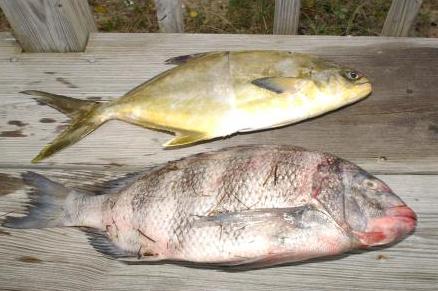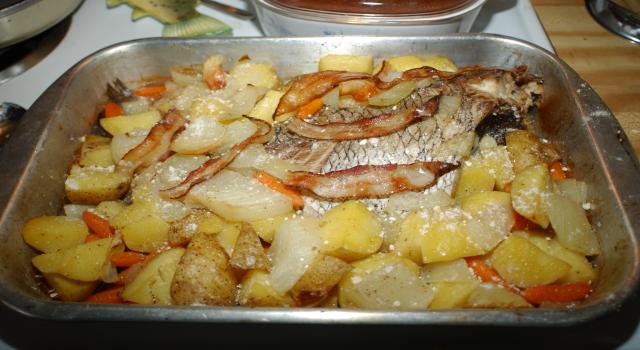| 10-13-03
Avon, NC--Stars
of the show were a seven-poundish sheepshead and a three-poundish pompano.
It was my night to fix dinner for our crew at North Carolina's famed
Outer Banks, and they were my centerpieces.
There were, of course, other great dishes (prepared by other members
of our vacation crew), and there even were other species of fish--spot,
Taylor blues, and even chicken of the sea (a.k.a. blowfish, or toad). But
the big, baked sheepshead and the pan-fried pompano fingers were show stoppers.
It was all quite easy, starting with dressing (or should that be undressing?)
the fish.
I wanted the sheepshead in one large piece for baking. So I scaled it
with a large spoon from the kitchen, cut off the head, cleaned out the
body cavity (including some large deposits of fat), and pronounced it fit
for a baking pan. Big baking fish are a lot like game birds, in my cookbook.
They need to be baked with skin and bones.
I filleted my first big pompano (the size I usually catch are more like
bluegills), and removed the skin, even though this species is not heavily
scaled. If I planned to bake a big pompano, I probably would remove whatever
scales were present and leave the skin on.
At this point, to be brutally honest, I probably should "sheepishly"
admit that sheepshead and pompano were caught on a silver hook at the Avon
Fish House. I was a few days late to hit the big sheepshead run at the
Avon Fishing Pier. This is somewhat academic, I believe, because fish caught
by commercial fishermen tend to taste just as good as the ones I catch.
Now for the cooking, which was just as easy. I placed the big
sheepshead in a shallow (two-inch sides) aluminum pan and rubbed it with
olive oil inside and out. With enough potatoes for 11 diners, chunks of
one large onion, and carrot sticks well salted and peppered, I tossed them
in olive oil and filled the fish cavity and available open space around
it. A few strips of bacon across the top of the fish completed my dish,
which was covered with foil and baked at 400 degrees until the veggies
were tender (about two hours). At that point the oven was turned off, and
the foil removed to crisp the bacon and brown the veggies.
The pompano filets were cut crosswise into finger-like strips, salted
and peppered, dipped in a mixture of egg and milk, rolled in an equal-parts
mixture of finely-rolled Keebler Club crackers, and flour, before fast
frying to a golden brown on all sides in olive oil.
Incidentally, frying the pompano fingers--any fish--requires constant
attention to avoid overcooking. Check down sides often to avoid burning.
Golden brown on all sides says the fish is done.
MORE ON FISH COOKERY
Readers of this column probably are familiar with my procedures for
saving meat that might otherwise be wasted when a fish is filleted. A seasoned
commercial fisherman here put a new wrinkle in my thinking.
His idea (name unknown) supports my thinking that filleting fish leaves
a lot of good food on the bones. But he boosts my thinking a notch or two
by pointing out that he filets fish, but that folks in this seashore town
fry the bones right along with the filets.
"Fried bones offer a lot of good fish," he says.
That lesson came after I had "cleaned" the pompano. But the meat on
the pompano bones was not wasted. I parboiled the bones, picked off the
good meat and turned it into a skillet of pompano a la king with hot homemade
biscuits.

|

|
| The
sheepshead (bottom) is not a favorite of many salt water anglers, but offers
flaky white meat that is delicious. The streamlined pompano (top) is both
beautiful and tasty. Pompano feed on sand fleas in the surf, often very
close in the last breaker. |
My
sheepshead, baked with veggies, proved a popular dish.
[Click
on photos to see larger images.]
|
|

